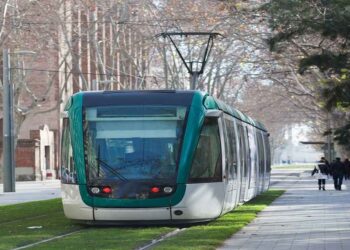Additive manufacturing (AM) has made significant strides within the transportation industry, yet there remains untapped potential for further advancements. Despite this journey ahead, select sectors within transportation recognize the numerous benefits AM offers and are leveraging them to enhance their operations.
One sector where AM has indeed come into its own is rail. A prime example of this is Deutsche Bahn, Germany’s national railway company, which now uses 3D printers to increase the speed and efficiency of railcar maintenance. Specifically, Deutsche Bahn uses next-gen plastic polymers to 3D print train replacement parts.
The most significant benefit for Deutsche Bahn is that it is no longer at the mercy of supply chain mayhem and raw materials shortages. With AM, it can produce the right parts at the right time to keep trains rolling for passengers rather than sitting idle in workshops. Deutsche Bahn is also exploring 3D printing’s potential to reduce costs and increase resource efficiency compared to traditional manufacturing methods.
Meanwhile, Alstom, known for its cutting-edge high-speed engines and rail cars, faces the challenge of maintaining aging fleets, some exceeding 30 years in service. The need for maintenance and replacement components is constant to prolong the life of these rail cars.
After installing an ultrafast 3D printer, the Alstom team quickly produced 30 footrests in just 10 hours. With significant cost savings compared to injection molding—€50 per part versus €200—over 100 replacement footrests have been installed in rail cars, highlighting the potential for increased utilization of 3D printing technology.
A lot of people still wonder if AM is ready for prime time. Use cases like Deutsche Bahn, which has 3D printed tens of thousands of replacement parts for its trains, and Alstom, which has achieved 75% cost reduction per part vs low volume molds, prove that it is.
Other transportation sectors are also embracing AM. Aviation uses 3D printing to rapidly produce parts on demand and introduce new efficiencies. For instance, aircraft require very specific tools that are often custom-made. With AM, it’s possible to print those tools on demand. This is a significant benefit because highly specialized custom tools traditionally cost upward of $50,000. The same tools can be 3D printed from advanced polymers for a fraction of the cost.
Automotive: The Next Frontier
The next big frontier for AM in transportation is the automotive industry. Already, momentum is building here. The BMW Group, for example, has launched a €15 million AM facility designed to shorten production times across the company. Ford Motor Co. is now autonomously operating 3D printers continuously with no human interaction, increasing throughput and reducing the cost of the custom-printed parts it uses.
The AM industry as a whole is now ready to enter into a certification and qualification pathway for a full range of automotive parts. Ford understands this. That’s why the automaker has begun employing 3D printers to make the low-volume custom parts for its performance package-equipped Mustang Shelby GT500. Indeed, AM, at this point, is ideally suited to manufacture original parts in low-volume production runs.
AM is also ideal for the service parts that go onto vehicles at auto repair shops. As anyone who has ever had a car in the shop for a non-routine repair knows, getting the right part can be a major pain point for consumers. It’s not unheard of for vehicles to sit at the repair shop for a week or longer before the right part arrives. Those wait times can be eliminated if service centers and car dealerships have the ability to print low-demand parts themselves rather than wait for them to be shipped on a one-off, case-by-case basis—especially now, with supply chains backed up around the world.
For instance, consider the case of French police cars. Stellantis recently sought bids to manufacture aftermarket components for 400 vehicles used by the French Gendarmerie. Leveraging a Nexa3D printer, R3D, a specialized design office in AM, successfully delivered 7200 custom brackets within three months. This achievement not only met stringent deadlines but also ensured the durability and reliability required for continuous 24/7 production.
Another reason 3D printed service parts make a lot of sense for automotive repair is that, currently, the cost of manufacturing repair parts is very high. The use of AM in this scenario can reduce manufacturing costs.
Solving the Supply Chain
And there’s one more reason why AM is perfect for the automotive industry: it can solve the supply-chain hang-ups that are making it almost impossible to take delivery of a new vehicle these days. Personally, I’ve been waiting for my new Ford Bronco for more than two years. I want to give Ford my money, but Ford doesn’t have the necessary parts to complete my vehicle. At this point, virtually every automaker is losing out on billions in revenue.
In the case of the Bronco, the holdup isn’t the engine or some other critical part. It’s the hardtop for the removable roof. Ford can’t produce it. But it is literally a removable part. So Ford could design that part using AM, build the first 10,000 or so vehicles quickly, and then swap out the 3D-printed part later when production is back at full capacity.
Looking to the future, AM can solve many problems in the transportation industry and bring many improvements. The bottom line is that AM is now ready for prime time. In automotive alone, it’s ready to enter a qualification and certification pathway that will driveaway-capable parts that can save billions of dollars in production costs.
Just as important, AM is ready to help transportation companies of all types build stronger businesses that can withstand the supply-chain disruptions we are contending with today—and the unknown disruptions we will surely contend with tomorrow.
By Avi Reichental, Co-Founder, Chairman & CEO, Nexa3D


































